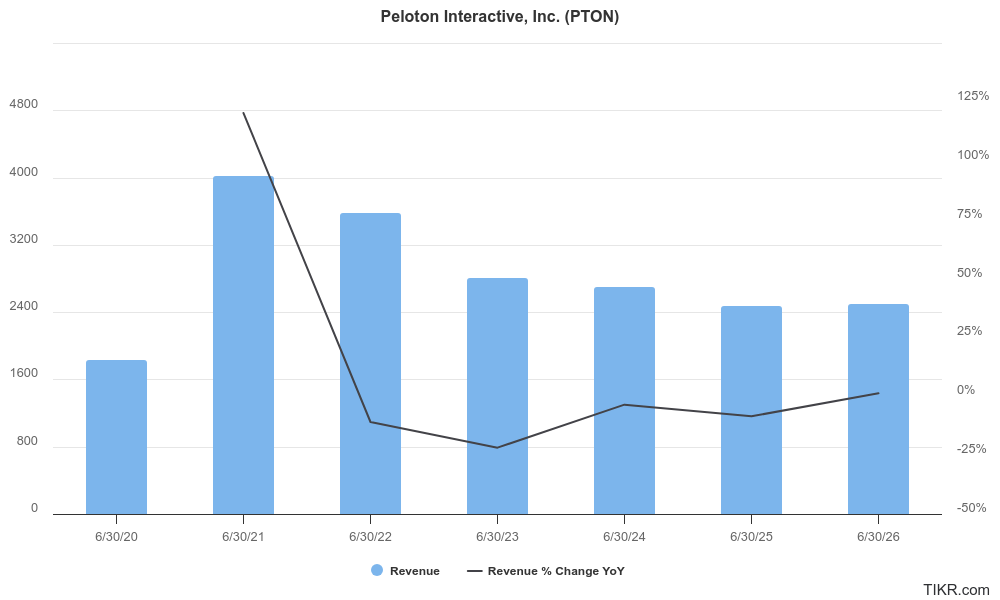Peloton Stock Has Doubled in the Last Six Months Amid Turnaround Hopes
Please note that we are not authorised to provide any investment advice. The content on this page is for information purposes only.
Peloton stock, which still trades at a fraction of its all-time highs, has almost doubled over the last six months amid hopes of a turnaround. The company has gone through some very troubling times over the last two years but some analysts see better days ahead for the fitness equipment company.
Table of Contents
PTON’s Sales Have Been Falling
Peloton’s fortunes have whipsawed since the onset of the COVID-19 pandemic. Its fitness equipment were the savior for many during the lockdowns and the company’s revenues more than doubled in the fiscal year 2020 and 2021.
The stock rose 440% in 2020 as stay-at-home stocks rallied and it was among the biggest beneficiaries of the change in consumer behavior. Many health enthusiasts bought Peloton’s equipment during the lockdowns as gyms were closed.
However, the tide started to turn for the home fitness company once the lockdowns were lifted. Peloton’s revenues fell YoY in the subsequent three fiscal year including double digit declines in the fiscal year 2022 and 2023.
In 2021, PTON stock fell 76% and was the worst-performing Nasdaq stock. While the entire stay-at-home pack saw selling pressure, PTON was especially under pressure. The stock plummeted in 2022 and 2023 as well, and fell to record lows, briefly becoming a penny stock.
Meanwhile, the pace of decline in Peloton’s revenues slowed down to 3.6% in the last fiscal year, analysts expect the company’s revenues to fall by another 8.5% in the current fiscal year.
Peloton Has Appointed a New CEO
In 2022, Peloton appointed former Netflix executive Barry McCarthy as its CEO who embarked on a turnaround plan to revive the fitness equipment maker. However, the stock continued to decline to new lows under his watch and eventually he stepped down as the CEO in May.
Last month, Peloton appointed Ford executive Peter Stern as its CEO. “Peter is a seasoned strategist with a track record of driving sustainable growth through innovation, and we have every confidence in his ability to lead Peloton during this important time. He brings meaningful expertise in scaling differentiated technology-oriented platforms and has a deep understanding of the health and wellness sector – making him uniquely suited to serve as Peloton’s next CEO,” said PTON’s CEO Jay Hoag in his prepared remarks.
Bank of America Upgraded Peloton Stock
After Stern was appointed as Peloton’s CEO, Bank of America upgraded the stock by tow notches to “outperform.” In its note, the brokerage said, “Peloton’s new CEO Peter Stern does not have public company CEO experience but meets all the criteria set by Peloton’s board including: 1) consumer software and hardware experience; 2) subscription services.”
Last month, Greenlight Capital’s David Einhorn who has been a longtime Tesla short seller said that Peloton stock is undervalued.
PTON Stock Rose After Earnings
Peloton reported better than expected earnings for its fiscal first quarter of 2025. It reported revenues of $586 million which were ahead of the $575 million that analysts were expecting. Importantly, it nearly reached a GAAP breakeven while analysts were predicting it to post a net loss in the quarter.
It guided for an adjusted EBITDA between $20 million-$30 million for the current quarter which was ahead of Street estimates. The company raised its full year adjusted EBITDA guidance to $240 million and $290 million versus the previous range of $200 million and $250 million.
The company guided for revenues of $650 million at the midpoint in the current quarter which fell short of the $671 million that analysts were expecting. Its paid app subscriber guidance of between 560,000-580,000 was also below Street estimates. While the guidance for the holiday quarter which is usually the biggest for Peloton was short of estimates, the company is upbeat over its outlook for the coming quarters.
“As we look ahead to the holiday season, we are already ramping up media spend to support demand generation ahead of this important time for hardware sales and subscriber additions,” said interim co-CEO Chris Bruzzo during the earnings call.
PTON’s Turnaround Plan
The management said that it was progressing on the cost cut plans faster than it had expected. The company has set the following goals for the current fiscal year
- Achieving run-rate cost savings of $200 million in the current fiscal year by aligning the cost base with the size of the business.
- Improving unit economics to generate meaningful cash flows
- Make strategic investments to grow the company’s topline growth
During the fiscal Q1 2025 earnings call, interim co-CEO Karen Boone said, “To enhance customer LTV, we are focused on expanding Connected Fitness products gross margin across all of our products, sales channels and markets, leading us to make certain pricing changes and reduce promotional activity in Q1. We are investing in marketing, product and content initiatives to drive engagement, which will improve subscriber growth and retention over the long term.”
Peloton Announced a Partnership with Costco
Recently, Peloton announced a partnership with Costco to sell its equipment through the retailer’s stores and online platform. Notably, while Peloton sold equipment through its own channels previously it changed track amid sagging sales and mounting costs of maintaining a large retail footprint.
Previously, it announced a partnership with Amazon to sell its fitness equipment on its platform. It also partnered with Dick’s Sporting Goods and Lululemon to see its hardware through their stores.
The company also announced a multiyear partnership with the NBA and WNBA and entered into a content deal with TikTok earlier this year.






